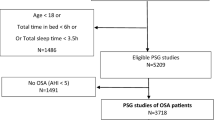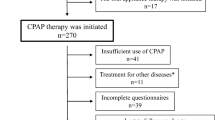Abstract
Purpose
Individuals have different breathing patterns at rest, during wakefulness, and during sleep, and patients with sleep apnea are no different. The hypothesis for this study was that breathing irregularity during wakefulness associates with CPAP acceptance in obstructive sleep apnea (OSA).
Methods
From a 2007–2010-database of patients with a diagnostic polysomnography (PSG) and prescribed CPAP (n = 380), retrospectively, 66 patients who quit CPAP treatment at 6 months were identified. Among them, 27 OSA patients quit despite having no side effects for discontinuing CPAP (Group A) and were compared to a matched group (age, body mass index, and apnea–hypopnea index) with good 6-month CPAP adherence (Group B; n = 21). Five minutes of respiratory signal during wakefulness at the initial PSG were extracted from respiratory inductance plethysmography recordings, and measured in a blinded fashion. The coefficients of variation (CV) for the breath-to-breath inspiration time (T i), expiration time (T e), T i + T e (T tot), and relative tidal volume, as well as an independent information theory-based metric of signal pattern variability (mutual information) were compared between groups.
Results
The CV for tidal volume was significantly greater (p = 0.001), and mutual information was significantly lower (p = 0.041) in Group A as compared to Group B.
Conclusions
Differences in two independent measures of breathing irregularity correlated with CPAP rejection in OSA patients without nasal symptoms or comorbidity. Prospective studies of adherence should examine traits of breathing stability.




Similar content being viewed by others
References
Shea SA, Guz A (1992) Personnalite ventilatoire—an overview. Respir Physiol 87(3):275–291
Shea SA, Benchetrit G, Pham Dinh T, Hamilton RD, Guz A (1989) The breathing patterns of identical twins. Respir Physiol 75(2):211–223
Kawakami Y, Yamamoto H, Yoshikawa T, Shida A (1984) Chemical and behavioral control of breathing in adult twins. Am Rev Respir Dis 129(5):703–707
Cherniack NS (1981) Respiratory dysrhythmias during sleep. N Engl J Med 305(6):325–330
Yamauchi M, Tamaki S, Yoshikawa M, Ohnishi Y, Nakano H, Jacono FJ, Loparo KA, Strohl KP, Kimura H (2011) Differences in breathing patterning during wakefulness in patients with mixed apnea-dominant vs obstructive-dominant sleep apnea. Chest 140(1):54–61
Basoglu OK, Midilli M, Midilli R, Bilgen C (2011) Adherence to continuous positive airway pressure therapy in obstructive sleep apnea syndrome: effect of visual education. Sleep Breath
Shapiro GK, Shapiro CM (2010) Factors that influence CPAP adherence: an overview. Sleep Breath 14(4):323–335
Yetkin O, Kunter E, Gunen H (2008) CPAP compliance in patients with obstructive sleep apnea syndrome. Sleep Breath 12(4):365–367
Gay P, Weaver T, Loube D, Iber C (2006) Evaluation of positive airway pressure treatment for sleep related breathing disorders in adults. Sleep 29(3):381–401
Sin DD, Mayers I, Man GC, Pawluk L (2002) Long-term compliance rates to continuous positive airway pressure in obstructive sleep apnea: a population-based study. Chest 121(2):430–435
Budhiraja R, Parthasarathy S, Drake CL, Roth T, Sharief I, Budhiraja P, Saunders V, Hudgel DW (2007) Early CPAP use identifies subsequent adherence to CPAP therapy. Sleep 30(3):320–324
Weaver TE, Grunstein RR (2008) Adherence to continuous positive airway pressure therapy: the challenge to effective treatment. Proc Am Thorac Soc 5(2):173–178
Simon-Tuval T, Reuveni H, Greenberg-Dotan S, Oksenberg A, Tal A, Tarasiuk A (2009) Low socioeconomic status is a risk factor for CPAP acceptance among adult OSAS patients requiring treatment. Sleep 32(4):545–552
Platt AB, Field SH, Asch DA, Chen Z, Patel NP, Gupta R, Roche DF, Gurubhagavatula I, Christie JD, Kuna ST (2009) Neighborhood of residence is associated with daily adherence to CPAP therapy. Sleep 32(6):799–806
Wild MR, Engleman HM, Douglas NJ, Espie CA (2004) Can psychological factors help us to determine adherence to CPAP? a prospective study. Eur Respir J 24(3):461–465
Shannon CE (1997) The mathematical theory of communication. 1963. MD Comput 14(4):306–317
Fraser AM, Swinney HL (1986) Independent coordinates for strange attractors from mutual information. Phys Rev A 33(2):1134–1140
Koo BB, Strohl KP, Gillombardo CB, Jacono FJ (2010) Ventilatory patterning in a mouse model of stroke. Respir Physiol Neurobiol 172(3):129–135
Dhingra RR, Jacono FJ, Fishman M, Loparo KA, Rybak IA, Dick TE (2011) Vagal-dependent nonlinear variability in the respiratory pattern of anesthetized, spontaneously breathing rats. J Appl Physiol 111(1):272–284
Jacono FJ, De Georgia MA, Wilson CG, Dick TE, Loparo KA (2010) Data acquisition and complex systems analysis in critical care: developing the intensive care unit of the future. J Healthc Eng 1(3):337–355
Kerr AM (1992) A review of the respiratory disorder in the Rett syndrome. Brain Dev 14(Suppl):S43–S45
Ogier M, Katz DM (2008) Breathing dysfunction in Rett syndrome: understanding epigenetic regulation of the respiratory network. Respir Physiol Neurobiol 164(1–2):55–63
Eckert DJ, Jordan AS, Merchia P, Malhotra A (2007) Central sleep apnea: pathophysiology and treatment. Chest 131(2):595–607
Netzer NC, Strohl KP (1999) Sleep and breathing in recreational climbers at an altitude of 4200 and 6400 meters: observational study of sleep and patterning of respiration during sleep in a group of recreational climbers. Sleep Breath 3(3):75–82
Pattinson KT (2008) Opioids and the control of respiration. Br J Anaesth 100(6):747–758
Teichtahl H, Wang D (2007) Sleep-disordered breathing with chronic opioid use. Expert Opin Drug Saf 6(6):641–649
Bradley TD, Floras JS (2003) Sleep apnea and heart failure: Part II: central sleep apnea. Circulation 107(13):1822–1826
Caples SM, Garcia-Touchard A, Somers VK (2007) Sleep-disordered breathing and cardiovascular risk. Sleep 30(3):291–303
Leung RS, Bradley TD (2001) Sleep apnea and cardiovascular disease. Am J Respir Crit Care Med 164(12):2147–2165
Cherniack NS, Longobardo G, Evangelista CJ (2005) Causes of Cheyne-Stokes respiration. Neurocrit Care 3(3):271–279
Hardavella G, Stefanache F, Ianovici N (2006) Cheyne stokes respiration in stroke patients. Rev Med Chir Soc Med Nat Iasi 110(1):82–87
Han F, Subramanian S, Dick TE, Dreshaj IA, Strohl KP (2001) Ventilatory behavior after hypoxia in C57BL/6J and A/J mice. J Appl Physiol 91(5):1962–1970
Han F, Subramanian S, Price ER, Nadeau J, Strohl KP (2002) Periodic breathing in the mouse. J Appl Physiol 92(3):1133–1140
Yamauchi M, Dostal J, Kimura H, Strohl KP (2008) Effects of buspirone on posthypoxic ventilatory behavior in the C57BL/6J and A/J mouse strains. J Appl Physiol 105(2):518–526
Yamauchi M, Ocak H, Dostal J, Jacono FJ, Loparo KA, Strohl KP (2008) Post-sigh breathing behavior and spontaneous pauses in the C57BL/6J (B6) mouse. Respir Physiol Neurobiol 162(2):117–125
Perez-Padilla R, West P, Kryger MH (1983) Sighs during sleep in adult humans. Sleep 6(3):234–243
Baldwin DN, Suki B, Pillow JJ, Roiha HL, Minocchieri S, Frey U (2004) Effect of sighs on breathing memory and dynamics in healthy infants. J Appl Physiol 97(5):1830–1839
Vlemincx E, Taelman J, De Peuter S, Van Diest I, Van den Bergh O (2011) Sigh rate and respiratory variability during mental load and sustained attention. Psychophysiology 48(1):117–120
Vlemincx E, Van Diest I, De Peuter S, Bresseleers J, Bogaerts K, Fannes S, Li W, Van Den Bergh O (2009) Why do you sigh? Sigh rate during induced stress and relief. Psychophysiology 46(5):1005–1013
Wuyts R, Vlemincx E, Bogaerts K, Van Diest I, Van den Bergh O (2011) Sigh rate and respiratory variability during normal breathing and the role of negative affectivity. Int J Psychophysiol 82(2):175–179
Wellman A, Eckert DJ, Jordan AS, Edwards BA, Passaglia CL, Jackson AC, Gautam S, Owens RL, Malhotra A, White DP (2011) A method for measuring and modeling the physiological traits causing obstructive sleep apnea. J Appl Physiol 110(6):1627–1637
Shannon CE, Weaver W (1949) The mathematical theory of communication. University of Illinois Press, Urbana
Acknowledgments
The authors would like to thank Kaoru Senzaki, RPSGT, for her help with polysomnogram scoring. This study is partly supported by a Grant-in-Aid for Young Scientists (B) (21790781) from The Ministry of Education, Culture, Sports, Science and Technology, Japan. US investigators were supported in part by the NIH-NHLBI [R33HL087340-01], and the VA Research Service.
Conflicts of interest
None of the authors have financial conflicts of interest to declare as it relates to the contents of this manuscript.
Author information
Authors and Affiliations
Corresponding author
Appendix
Appendix
Mutual Information: Mutual information (MI) is a measure of the statistical dependence between two time series, or two collections of points from a data set, that can arise from both linear and nonlinear sources [42]. The Mutual information between a given time series x(t) and its time-shifted version x(t + τ) is computed from the joint probability distribution of x(t) and x(t + τ), where τ represents a time lag. The joint probability distribution is defined as P[x(t), x(t + τ)], where P[x(t)] and P[x(t + τ)] are the marginal distributions of the original and time-shifted time series, respectively. The MI can be computed as follows:
Because the breathing pattern over long time periods is strongly periodic, we computed MI for τ values from one sample (adjacent points separated by 100 ms) to one cycle length. MI tends to decrease quickly as τ is increased from a lag of one and then becomes more uniform at higher time lags, and the average MI of a given epoch was quantified excluding small lags as defined by the first minimum of the MI function.
Rights and permissions
About this article
Cite this article
Yamauchi, M., Jacono, F.J., Fujita, Y. et al. Breathing irregularity during wakefulness associates with CPAP acceptance in sleep apnea. Sleep Breath 17, 845–852 (2013). https://doi.org/10.1007/s11325-012-0775-2
Received:
Revised:
Accepted:
Published:
Issue Date:
DOI: https://doi.org/10.1007/s11325-012-0775-2




